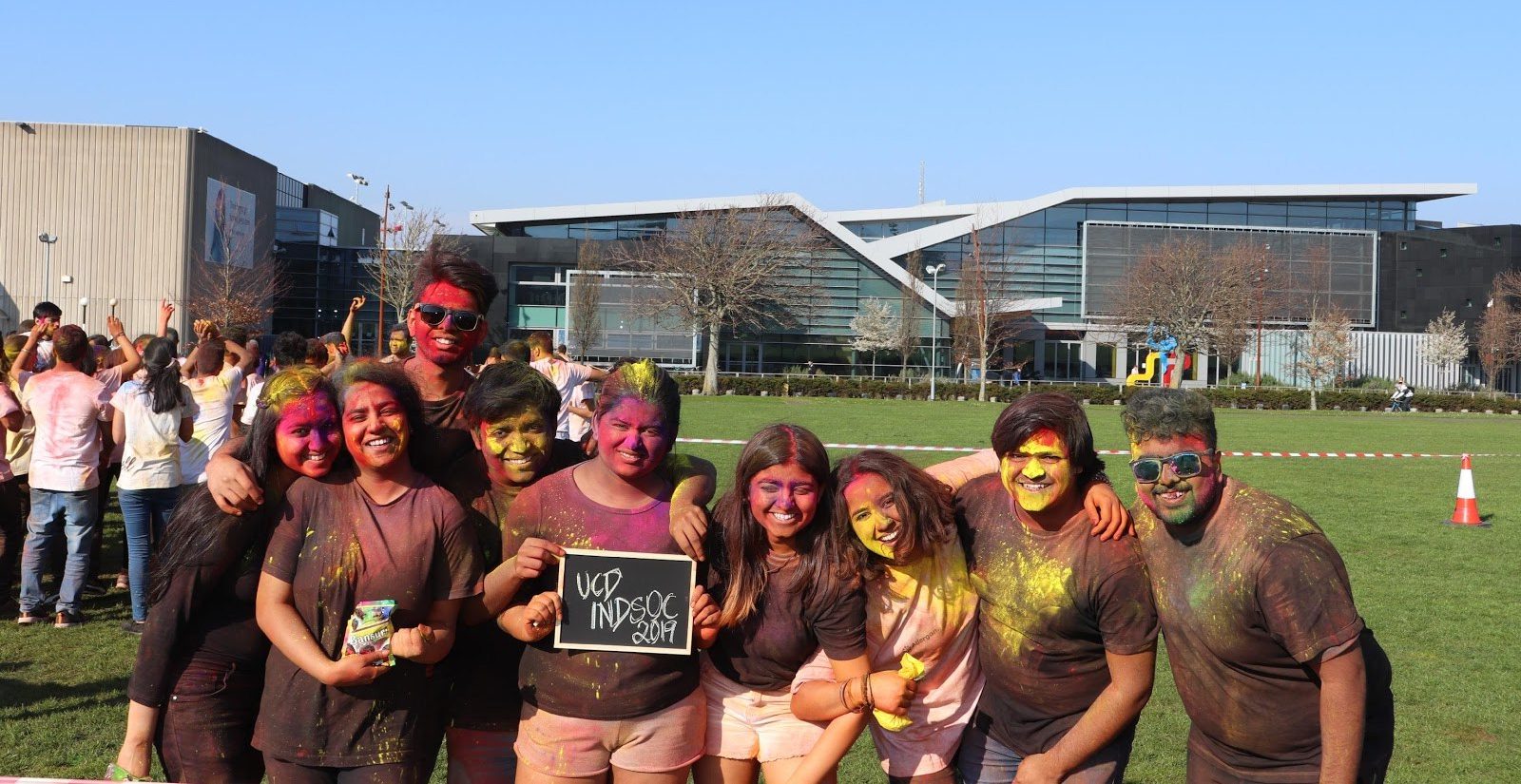UCD’s Indian Society celebrated Holi on 29th March 2019. Preparations for the festival began weeks in advance. It was a charity event sponsored by The Hope Foundation, which is a non-profit organization that works towards protection of street and slum children in Kolkata. Proceeds from selling more than a hundred tickets, white T-shirts and chocolates went to The Hope Foundation.
The celebration with ‘Gulal’ was held in the pitch outside the Student Centre. It was a unique celebration, with Bollywood music and a myriad of colours. The turn-out was great, and not limited to just Indians. All in all, it was a great event. If you missed out this time, do be on a lookout for next year’s Holi Celebration with IndSoc.
What is Holi?
Holi is a Hindu celebration, often known as ‘The Festival Of Colours’. The festival originated in ancient India during the pre-Christian era and while it is unknown exactly how old the festival is, the first mention of it in written text dates back to 4th-century poetry. Holi marks the beginning of spring and is celebrated throughout the Asian sub-continent during the Hindu month Phalguna. The timing of Holi is synchronized with the moon, and thus the dates of celebrations change each year, depending on the lunar cycles.
Why is Holi celebrated?
The mythical significance of the festival relates to a fable about Hiranyakashipu, a demon king. According to Bhagavata Purana (one of Hindu’s holy texts), the deity Vishnu killed Hiranyakashipu’s younger Brother, Hiranyaksha. Subsequently, Hiranyakashipu decided to undergo many years of great penance to please Brahma (the creator of the universe, who is also known as Vedanta: god of Vedas, Gyaneshwar: God of Knowledge, and Svayambhu: self-born). Brahma, on becoming pleased by Hiranyakashipu’s austerities, offered him a favour, that the demon king chose to use to avenge his younger brother’s death.
During Hiranyakashipu’s period of penance, Indra (the king of the highest heaven) attacked his home. Narad (the divine sage) regarded Hiranyakashipu’s wife Kayadhu and her unborn child Prahlad as ‘sinless’. During her pregnancy, Kayadhu’s unborn son had become affected by the transcendental instructions of Narad. As Prahlad started gaining a sense of his surrounding, he began to express signs of Narad’s prenatal training and became a devoted follower of Vishnu. Much to his father’s disappointment, Prahlad refused to recognise his father as the supreme lord of the universe. This caused Hiranyakashipu to become bitter towards his own son, and he decided to kill him. However, Hiranyakashipu’s attempts to kill Prahlad were unsuccessful, as he was protected by Vishnu’s mystical power.
Hiranyakashipu’s sister was Holika and she had a blessing that prevented her from being affected by the element of fire. In an attempt to kill Prahlad, she sat in a burning pyre with him on her lap. Hiranyakashipu believed that Prahlad would turn to ashes, while his beloved sister would remain unharmed. As the pyre was set on fire, Prahlad started to chant Vishnu’s name and in the battle of good against evil, Holika was burnt down and Prahlad remained unharmed.
The burning of Holika is celebrated in Hinduism as the festival of Holi. This story has effectively created the faith that ultimately the forces of divinity shall triumph over the demonic forces.
Symbolically, a bonfire of Holika is made in every town or village in the evening. This is known as ‘Holika Dahan’, a practice that takes place on the eve of Holi. It is also known as the ‘Chhoti Holi’ or Small Holi. During ‘Holika Dahan,’ bonfires are lit to commemorate Prahlad ’s victory against his evil father and his sister. It is a reminder that good always triumphs over evil.
What is ‘Gulal’?
The scented coloured powder used during Holi is called ‘Gulal’, also known as ‘Abeer’. The many colours of Gulal symbolize happiness, vibrancy, love, and cheers in the festival of Holi. Gulal is smeared on loved ones to wish them a Happy Holi, it is also applied to the feet of elders to wish them with festive greetings.
What is the significance of ‘Gulal’?
According to the Hindu belief, it was Krishna, who popularised the tradition of Holi. The significance of throwing coloured powder can be traced back to Lord Krishna, who was self-conscious of his dark blue skin, he was afraid that his beloved Radha would not accept him. When Krishna told his mother about his fears, she told him to colour Radha’s face with any colour of his choice. Krishna was extremely delighted in applying colour on Radha because he felt a sense of belonging. This later became a part of the Holi celebration.
It is believed that Krishna enchants the world, but Radha enchants even Him, therefore she is the supreme goddess of all. Radha and Krishna are the power couple, in Hindu mythology. Applying ‘Gulal’ on each other during Holi celebrates the immortal love of Krishna and Radha.
By Vanshika Dhyani – Arts & Lifestyle Writer
Photo credit: Rajit Banerjee

